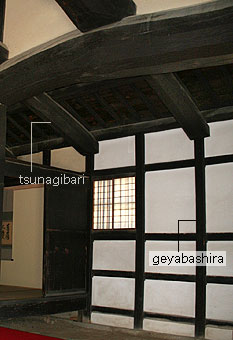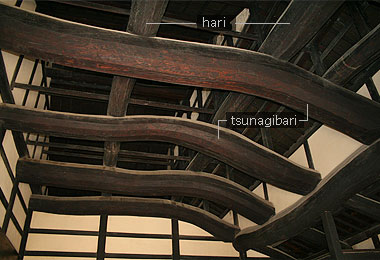|
||
 |
||
1@Also *geyabari º®À. A short beam which connected the top of the *geyabashira º®, a post at the outside of the lean-to roof *geya º®, or the eaves purlin *geyageta º® , to the side of the *jouyabashira ã®, a post at the boundary between main building *jouya ã® and the lean-to roof. The beam linked the jouya and geya posts and thus rendered the structure of the geya more stable. It sometimes supported a strut *tsuka ©, bearing the end of the main transverse beam *jouyabari ã®À.

Nagatomi
ix house (Hyougo)
2@In many districts, a beam that ran parallel to the ridge of the roof *ketayuki s, supported by beams *hari À, that ran in a transverse direction *harima ÀÔ. The tsunagibari functioned as a support for the feet of roof struts koyazuka ¬®©, and provided longitudinal stability for the structure.

Nagatomi
ix house (Hyougo)
3@An intermediate transverse beam in the roof structure *koyagumi ¬®g, of large scale thatched roof vernacular houses *minka ¯Æ, connecting the main transverse beam and the ridge of the roof. The tsunagibari helped to tie the roof structure together.
4@Slender transverse beams that joined the long struts supporting the roof ridge *shinzuka ^© to the flanking parallel pairs of struts *toriizuka ¹© in the rafter-structure *taruki kouzou Ø\¢, system of roof assembly.
@
(C)2001 Japanese Architecture and Art Net Users System.@No reproduction or republication without written permission.
fÚÌeLXgEÊ^ECXgÈÇASÄÌRec̳f¡»E]ÚðֶܷB

